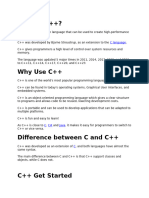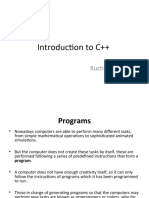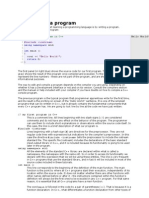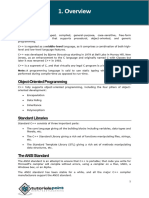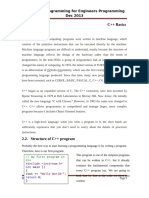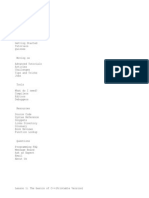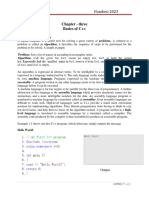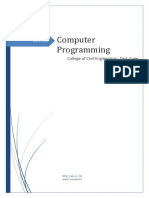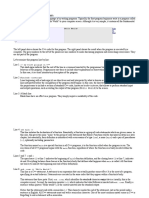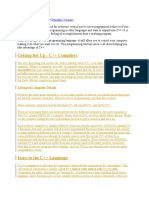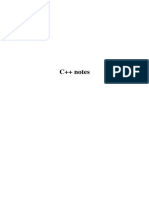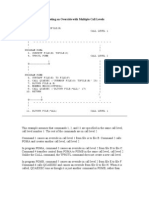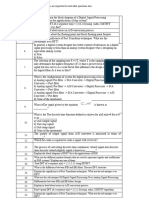Introduction To C++: Hello World!
Introduction To C++: Hello World!
Uploaded by
yashbanwani2014Copyright:
Available Formats
Introduction To C++: Hello World!
Introduction To C++: Hello World!
Uploaded by
yashbanwani2014Original Title
Copyright
Available Formats
Share this document
Did you find this document useful?
Is this content inappropriate?
Copyright:
Available Formats
Introduction To C++: Hello World!
Introduction To C++: Hello World!
Uploaded by
yashbanwani2014Copyright:
Available Formats
Introduction to C++
1
Introduction to C++
Hello World!
The first program that most aspiring programmers write is the classic "Hello World" program. The purpose of this
program is to display the text "Hello World!" to the user. The "Hello World" example is somewhat famous as it is
often the first program presented when introducing a programming language
[1]
.
#include <iostream>
using namespace std;
int main()
{
cout << "Hello World!" << endl;
cin.get();
return 0;
}
NOTE:
The 'return 0;' as shown above, is not a necessary addition to the 'hello world' program. A return value of 0 in main
simply signals to the operating system that everything went smoothly. By default, a C++ program will always return
0 if there is no return at the end of main.
Understanding the Code
Before discussing the particulars, it is useful to think of a computer program simultaneously in terms of both its
structure and its meaning.
A C++ program is structured in a specific, particular manner. C++ is a language and therefore has a grammar similar
to a spoken language like English. The grammar of computer languages is usually much, much simpler than spoken
languages but comes with the disadvantage of having stricter rules. Applying this structure or grammar to the
language is what allows the computer to understand the program and what it is supposed to do.
The overall program has a structure, but it is also important to understand the purpose of part of that structure. By
analogy, a textbook can be split into sections, chapters, paragraphs, sentences, and words (the structure), but it is also
necessary to understand the overall meaning of the words, the sentences, and chapters to fully understand the content
of the textbook. You can think of this as the semantics of the program.
A line-by-line analysis of the program should give a better idea of both the structure and meaning of the classic
"Hello World" program.
Introduction to C++
2
A Detailed Explanation of the Code
#include
#include <iostream>
The hash sign (#) signifies the start of a preprocessor command. The include command is a specific preprocessor
command that effectively copies and pastes the entire text of the file specified in the angled brackets into the source
code. In this case the file is "iostream" which is standard file which should come with the C++ compiler. This file
name is short for "input-output streams"; in short, it contains code for displaying and getting text from the user.
The include statement allows a program to "include" this functionality in the program without having to literally cut
and paste it into the source code every time. The iostream file is part of C++ standard library, which provides a set
of useful and commonly used functionality provided with the compiler. The "include" mechanism, however, can be
used both for standard code provided by the compiler and for reusable files created by the programmer.
using namespace std
using namespace std;
C++ supports the concept of namespaces. A namespace is essentially a prefix that is applied to all the names in a
certain set. The using command tells the compiler to allow all the names in the "std" namespace to be usable
without their prefix. The iostream file defines three names used in this program - cout, cin, and endl - which are
all defined in the std namespace. "std" is short for "standard" since these names are defined in the standard C++
library that comes with the compiler.
Without using the std namespace, the names would have to include the prefix and
be written as std::cout, std::cin, and std::endl.
int main()
The entry point of all C++ programs is the main function. This function is called by the operating system when your
program is loaded.
cin, cout
cout << "Hello, World!" << endl;
cin.get();
The name cout is short for "character output" and cin, correspondingly, is an abbreviation for "character input".
In a typical C++ program, most function calls are of the form object.function_name(argument1,
argument2), such as cin.get() in the example above (where cin is the object, get is the function name,
and there are no arguments in the argument list). However, symbols such as << can also behave as functions, as is
done with cout in this case. This functionality is called operator overloading which will be discussed later.
Introduction to C++
3
{ }
A block of code is defined with the { } tokens. { signifies the start of a block of code and } signifies the end.
NOTE: The { } tokens have other functions.
semicolons
Each statement in C++ is ended by a semicolon. This is very roughly the equivalent of a sentence in a language like
English. This tells the compiler where one operation ends and the next begins.
Note that it is common to hear someone refer to a "line of C++ code". This often can actually mean a single
statement rather than literally a single line of text, since most programmers prefer a style of one line of text per
statement.
return
The return keyword stops the function where it is and returns a value (the return type must match the function's type)
to the calling function. Using the return keyword is mainly effective to stop the program.
Compiling the code
In order for the computer to run the code you have written, it needs to first be compiled by a C++ compiler. In short,
a compiler changes the program into a form that the computer can more directly understand.
What the compiler does
In very broad terms, the compiler is a translator that acts as an intermediary between the programmer and the CPU
on the computer. A high-level language like C++ is actually a sort of 'compromise' language between the native
language of the CPU (generally referred to as machine language) and the native language of the programmer (say
English). Computers do not natively understand human languages, yet for someone to write computer code in the
native language of the machine would be too difficult and time consuming. Therefore, the purpose of the computer
language itself is to define a mid-point that is closer to how humans think and organize procedures but is still
unambiguously translatable to the native machine language.
The compiler therefore is reading in the code written by the programmer and translating it into machine language
code, that the computer can understand directly.
C++ is a compiled language that is converted to machine language by the compiler. Beginning programmers will
likely also come across the notion of interpreted languages and interpreters. Since this text covers C++, interpreted
languages are not covered in detail; however, in brief, an interpreter is like a compiler that converts the program into
machine language at the time it is run on the computer rather than in advance as is done with a compiled language.
An example of a interpreted language is Java.
Running the compiler
The code needs to be compiled with a compiler to finish the process. What if you don't have one? Well, the good
news is, there are tons of good compilers that are available for free. The GNU Compiler Collection (GCC) has
versions available for most systems and does a good job of implementing the ISO C++ standard. However, many
people prefer to use an Integrated Development Environment (IDE) which provides a user friendly environment for
developing programs. For MacOS X, there is Xcode which uses gcc for compiling C++. For Windows, there is Dev
C++ which also uses gcc for compiling C++, Microsoft Visual C++ (and it's free Express version), TCLITE, and
ports of the GNU Compiler Collection distributed within Cygwin and MinGW.
Each compiler has its own way of compiling programs. If you use GCC, type the following in a terminal:
Introduction to C++
4
g++ example.cpp -o example
Replace example.cpp with the actual name of the file you wish to compile. Replace example with the name
you wish to give the executable program.
If you want to use a specific compiler, you will need to read up on that particular compiler.
Where To Go Next
Topics in C++
Beginners Data Structures Advanced
Lesson 1: Introduction to C++ Lesson 8: Pointers Lesson 12: The STL
Lesson 2: Variables and User Input Lesson 9: Classes and Inheritance Lesson 13: STL Algorithms
Lesson 3: Simple Math Lesson 10: Templates 1
Lesson 4: Conditional Statements Lesson 11: Templates 2
Lesson 5: Loops
Lesson 6: Functions and Recursion
Lesson 7: More Functions
Part of the School of Computer Science
References
[1] Examples of programs in different programming languages (http:/ / www. ntecs. de/ old-hp/ uu9r/ lang/ html/ lang. en. html)
C Preprocessor article at Wikipedia.
Article Sources and Contributors
5
Article Sources and Contributors
Introduction to C++ Source: http://en.wikiversity.org/w/index.php?oldid=838878 Contributors: AmiDaniel, Autumnfields, Billsmith, Cap356, Clavin12, Crochet.david, Cybiko123, Darklama,
Dominis, Frigotoni, Giawa, Heckler0077, JWSchmidt, Javacob, Miklcct, NiGHTS, Niks2k6, Pjanssen, Pnguyen, Pranabnaik, Rayc, Remi, Richard2me, Shatner, Sigma 7, Sj, Swgeek54, Synergy,
T prev, V2os, Yun-Yuuzhan, 61 anonymous edits
License
Creative Commons Attribution-Share Alike 3.0 Unported
//creativecommons.org/licenses/by-sa/3.0/
You might also like
- C++ IntroductionDocument217 pagesC++ IntroductionRickson Viahul Rayan C100% (10)
- 00c++ Session 1Document5 pages00c++ Session 1CHRISTIAN ABEBINo ratings yet
- Lab 9 v1Document27 pagesLab 9 v1Abdul BasitNo ratings yet
- Computer 1Document15 pagesComputer 1Jafar AbduNo ratings yet
- C++ ProgrammingDocument7 pagesC++ Programmingengineerhaile1No ratings yet
- c++ Programming 1 ManfgDocument18 pagesc++ Programming 1 Manfgtdfg1908No ratings yet
- CP1 - Unit 2 - C ProgLag and Its StructureDocument10 pagesCP1 - Unit 2 - C ProgLag and Its StructureNathaniel NapayNo ratings yet
- Chapter 2-C++ BasicsDocument20 pagesChapter 2-C++ BasicsShaggYNo ratings yet
- CLASS 7: C++ NOTES (Compiled By: Computer Dept.-Main Branch CBS)Document4 pagesCLASS 7: C++ NOTES (Compiled By: Computer Dept.-Main Branch CBS)Appy PrinceNo ratings yet
- Introduction Week#1Document6 pagesIntroduction Week#1ab7422360No ratings yet
- How To Write and Compile CDocument9 pagesHow To Write and Compile CMichael Kwatelai QuarteyNo ratings yet
- Zxczcuweruthwuer 794797495Document115 pagesZxczcuweruthwuer 794797495mainaephraim356No ratings yet
- ProgramDocument8 pagesProgramFederico, Aries C.No ratings yet
- Lesson 1 Introduction To CDocument32 pagesLesson 1 Introduction To Cedwardpoley5No ratings yet
- C++ Notes (Unit-1,2,3)Document138 pagesC++ Notes (Unit-1,2,3)ramesh yadavNo ratings yet
- Introduction To C++: Ruchi MehtaDocument8 pagesIntroduction To C++: Ruchi MehtadeepakrguptaNo ratings yet
- Structure of A Program - PLDDocument3 pagesStructure of A Program - PLDReyn MayoyoNo ratings yet
- Structure of A ProgramDocument4 pagesStructure of A ProgramGagandeep SinghNo ratings yet
- Programming Fundamentals Lab ManualDocument40 pagesProgramming Fundamentals Lab ManualsajId146No ratings yet
- C++ Programming LanguageDocument54 pagesC++ Programming Languageسرحان سويد عيسىNo ratings yet
- Notes 2Document47 pagesNotes 2shubhpsNo ratings yet
- Programming Chapter 2Document20 pagesProgramming Chapter 2atakiltiNo ratings yet
- NewtonDocument73 pagesNewtonNewton NyathiNo ratings yet
- Chapter 3Document25 pagesChapter 3habtamufikru96No ratings yet
- Programming-An-Overview/4.html: HistoryDocument17 pagesProgramming-An-Overview/4.html: Historysukanyas111No ratings yet
- Object-Based Programming Is The Style of Programming That Primarily SupportsDocument5 pagesObject-Based Programming Is The Style of Programming That Primarily SupportsThe ScholarNo ratings yet
- Algorithm & Computing: Lab # 1 DE-32 DCEDocument18 pagesAlgorithm & Computing: Lab # 1 DE-32 DCEUmais BhuttaNo ratings yet
- Introduction To C++ ProgrammingDocument33 pagesIntroduction To C++ ProgrammingFredrick OuyaNo ratings yet
- Microsoft Press - Visual C++.NET Step by Step PDFDocument68 pagesMicrosoft Press - Visual C++.NET Step by Step PDFshitNo ratings yet
- C++ Lec1-Introduction+Output+NewlineDocument9 pagesC++ Lec1-Introduction+Output+NewlineRastyNo ratings yet
- Introduction To C ProgrammingDocument47 pagesIntroduction To C ProgrammingramindercheemaNo ratings yet
- ITC Lecture 2Document23 pagesITC Lecture 2Ahmad ShahbazNo ratings yet
- Introduction To C ProgrammingDocument81 pagesIntroduction To C ProgrammingAshish Kadam100% (1)
- c ProgrammingDocument38 pagesc Programmingdmchotel54No ratings yet
- Computer Programming: College of Civil Engineering - First StageDocument5 pagesComputer Programming: College of Civil Engineering - First StageAli ANo ratings yet
- Chapter - 2 - Fundamentals of C++ ProgrammingDocument16 pagesChapter - 2 - Fundamentals of C++ ProgrammingFikadu100% (1)
- Structure of A ProgramDocument55 pagesStructure of A ProgramEsmeralda ConradNo ratings yet
- 01.basics of C++Document13 pages01.basics of C++ramiNo ratings yet
- Chap 01Document25 pagesChap 01anon-143950No ratings yet
- 1 IntroductionDocument16 pages1 IntroductionRashmi AnganeNo ratings yet
- L2 - INTRODUCTION TO C++ PROGRAMINGDocument29 pagesL2 - INTRODUCTION TO C++ PROGRAMINGlkixomeNo ratings yet
- Lecture 4Document29 pagesLecture 4Muneeb AshrafNo ratings yet
- 2.Programming and problem SolvingDocument20 pages2.Programming and problem Solvingrandsand97No ratings yet
- Electives Research PAGESDocument267 pagesElectives Research PAGESPauline CemitaraNo ratings yet
- Chapter 2 Basic Concepts of C++ ProgrammingDocument40 pagesChapter 2 Basic Concepts of C++ ProgrammingEndalkachew EmareNo ratings yet
- Introduction To C/C++ Programming: DR Zulkefli Bin Mansor 28 Sept 2015Document33 pagesIntroduction To C/C++ Programming: DR Zulkefli Bin Mansor 28 Sept 2015Mohamad ZulfikrieNo ratings yet
- Part 3 - Syntax and Semantics of ProgrammingDocument24 pagesPart 3 - Syntax and Semantics of Programmingbernaleighsande88No ratings yet
- Getting Set Up - C++ Compilers: Advanced Compiler DetailsDocument6 pagesGetting Set Up - C++ Compilers: Advanced Compiler Detailskarlooz1No ratings yet
- C & C++ LanguageDocument12 pagesC & C++ Languageالزهور لخدمات الانترنيتNo ratings yet
- C++ NotesDocument45 pagesC++ NotesDheeraj Mishra67% (3)
- Ghid Primul Program in CDocument11 pagesGhid Primul Program in CSimona AlexandraNo ratings yet
- Introducing C Plus Plus - Lecture NotesDocument21 pagesIntroducing C Plus Plus - Lecture Noteskamiru23.alexNo ratings yet
- Compiler Based: Example HTMLDocument5 pagesCompiler Based: Example HTMLIndhu McamphilNo ratings yet
- Problem Solving Using C Programming: Course Code: B20EN0304Document42 pagesProblem Solving Using C Programming: Course Code: B20EN0304Penrose LearningNo ratings yet
- C++ TutorialDocument122 pagesC++ Tutorialmirkumrosnam8977No ratings yet
- COMPUTING FOR CIVIL ENGINEERS All ChaptersDocument42 pagesCOMPUTING FOR CIVIL ENGINEERS All ChaptersMUSIBIRA PAULNo ratings yet
- C MaterialDocument274 pagesC Material727822TUEC243 THARUN S INo ratings yet
- Structure of A ProgramDocument4 pagesStructure of A ProgrammefiestoNo ratings yet
- 3 Simple AmthDocument3 pages3 Simple Amthyashbanwani2014No ratings yet
- The STL: The Standard Template LibraryDocument5 pagesThe STL: The Standard Template Libraryyashbanwani2014No ratings yet
- 10 Templates Part 1Document11 pages10 Templates Part 1yashbanwani2014No ratings yet
- 11 Templates Part 2Document3 pages11 Templates Part 2yashbanwani2014No ratings yet
- 8 PointersDocument4 pages8 Pointersyashbanwani2014No ratings yet
- VCV CXB CCNBFVBFCGXC VNVCN Vcnxdcvnxbcfhbxddsafcdsvfgsadgvbzfshfscxvbxbvxzsdsafgdshgf VNBVNVNVNBDocument8 pagesVCV CXB CCNBFVBFCGXC VNVCN Vcnxdcvnxbcfhbxddsafcdsvfgsadgvbzfshfscxvbxbvxzsdsafgdshgf VNBVNVNVNBnareshhhhhNo ratings yet
- ThinkPad X1 Carbon Gen 8 SpecDocument8 pagesThinkPad X1 Carbon Gen 8 SpecomarNo ratings yet
- Article 8 Uses of Pointers in C Alex ViaDocument8 pagesArticle 8 Uses of Pointers in C Alex ViadarkneswarNo ratings yet
- Assessment II - Desktop ManagementDocument25 pagesAssessment II - Desktop ManagementKushal BajracharyaNo ratings yet
- Slaa 089 FDocument2 pagesSlaa 089 FI lensesNo ratings yet
- Ka-Band Vs Ku-Band Satellite SystemDocument2 pagesKa-Band Vs Ku-Band Satellite SystemOKORIE ChikezieNo ratings yet
- DLTOVRDocument5 pagesDLTOVRMaran GanapathyNo ratings yet
- Basic Linux Commands by T@R@24Document2 pagesBasic Linux Commands by T@R@24Craciun MariusNo ratings yet
- Smart PodiumDocument2 pagesSmart Podiumdr gawdatNo ratings yet
- CA Lecture 9 1Document9 pagesCA Lecture 9 1260105.khushiNo ratings yet
- Skema Toshiba c805 By3 By4Document49 pagesSkema Toshiba c805 By3 By4glepunkNo ratings yet
- LO-Cockpit V1 and V2 UpdateDocument12 pagesLO-Cockpit V1 and V2 UpdateRavindra BabuNo ratings yet
- TroubleshootingDocument28 pagesTroubleshootingRisoSilvaNo ratings yet
- Cloud Computing - Chapter 2Document47 pagesCloud Computing - Chapter 2nadah4197No ratings yet
- GSM Based Vending MachineDocument7 pagesGSM Based Vending Machinejcara4309100% (1)
- CDE (Radial Thru-Hole) 400C SeriesDocument5 pagesCDE (Radial Thru-Hole) 400C Seriesjghjkhgkh87No ratings yet
- LXC61X0 V1.3 en 2017112002Document10 pagesLXC61X0 V1.3 en 2017112002Hector CabreraNo ratings yet
- Fichas TecnicasDocument34 pagesFichas TecnicasjorgealfonsoortizcNo ratings yet
- Chapter 07Document13 pagesChapter 07Alex WilliamsNo ratings yet
- Types of RAMDocument2 pagesTypes of RAMCerina Avergonzado BuendiaNo ratings yet
- Dspa Question BankDocument2 pagesDspa Question BankPanku RangareeNo ratings yet
- SNOC - CM - MOP - 3G - NODEB - VLAN Change - ZTE - v1.0Document12 pagesSNOC - CM - MOP - 3G - NODEB - VLAN Change - ZTE - v1.0Mohammad AslamNo ratings yet
- 306 Computer Network Unit 3Document64 pages306 Computer Network Unit 3rdxraushan2005No ratings yet
- Mic Report G2Document5 pagesMic Report G2Prathmesh GalheNo ratings yet
- Linux EssentialsDocument76 pagesLinux EssentialsTaryani TaryaniNo ratings yet
- Unlock Huawei E1731 USB Modem Airtel 3G Solved Working Geek Mechanix PDFDocument20 pagesUnlock Huawei E1731 USB Modem Airtel 3G Solved Working Geek Mechanix PDFvetrivelNo ratings yet
- Ólafur Arnalds Evolutions - User ManualDocument22 pagesÓlafur Arnalds Evolutions - User ManualDiego PerezNo ratings yet
- T3 D168IW User ManualDocument19 pagesT3 D168IW User ManualDiaa PrihartoNo ratings yet
- Op-Amp Errors, Another View: AN127 Dataforth Corporation Page 1 of 7Document7 pagesOp-Amp Errors, Another View: AN127 Dataforth Corporation Page 1 of 7محمد المحمديNo ratings yet
- Smart InvertersDocument12 pagesSmart Invertersسيد الخواتمNo ratings yet





